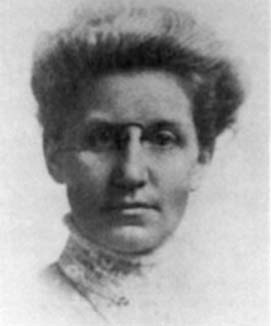


 تاريخ الرياضيات
تاريخ الرياضيات
 الرياضيات في الحضارات المختلفة
الرياضيات في الحضارات المختلفة 
 الرياضيات المتقطعة
الرياضيات المتقطعة
 الجبر
الجبر
 الهندسة
الهندسة 
 المعادلات التفاضلية و التكاملية
المعادلات التفاضلية و التكاملية 
 التحليل
التحليل
 علماء الرياضيات
علماء الرياضيات |
Read More
Date: 15-4-2017
Date: 19-4-2017
Date: 11-4-2017
|
Died: 9 March 1917 in Columbia, Missouri, USA

Agnes Baxter's father was Robert Baxter. Robert Baxter and his wife were Scottish and Robert had been the manager of an electric light company in Scotland before emigrating to Nova Scotia. The family settled in Halifax and that is where Robert was employed by the Halfax Gas Light Company, first as a foreman and later as manager.
Little is known of Agnes's childhood and pre-university education but we do know that her family were comapatively well off and she must have had good schooling. We do know that in 1887 she entered Dalhousie University and, after studying mathematics, she graduated with a B.A. with first class honours in Mathematics and Mathematical Physics in 1891.
Baxter had been taught mathematics at Dalhousie University by Charles Macdonald and mathematical physics by Gordon MacGregor and it must have been a difficult time for a woman taking what were considered at that time men's subjects. Although few women studied mathematics, she was not the only one studying mathematics at Dalhousie, for example there were two other women in the class of 24 that studied second level mathematics with Baxter. Her performance at university was outstanding and she was awarded a distinction and received the Sir William Young Gold Medal. With the award of her B.A. degree Baxter became the first ever woman to graduate with honours from Dalhousie University. But more than this, she had been clearly the best student in both mathematics and mathematical physics.
Baxter remained at Dalhousie University to take a Master's Degree in Mathematics, which she received in 1892. She was awarded a fellowship to study for her doctorate at Cornell University. There her doctoral studies were supervised by James Edward Oliver and, when she graduated in 1895, she became only the second Canadian woman to be awarded Ph.D. in Mathematics. In fact she was only the fourth woman to receive such a degree in the whole of North America. The degree was awarded for her thesis On Abelian Integrals, a Resume of Neumann's Abelsche Integral with Comments and Applications. James Oliver died in the year that Baxter was awarded her Ph.D. and his mathematical notes were edited by Baxter and later published.
Albert Ross Hill had graduated from Dalhousie University in the same year as Baxter and he had also studied for a doctorate at Cornell but his topic was philosophy, not mathematics. In 1896, the year after Ross Hill and Baxter were awarded their doctorates from Cornell, they married on 20 August and moved to Lincoln, Nebraska where Ross Hill became a proessor at the University of Nebraska. Baxter decided to give up her promising mathematics career in order to support her husband's academic career. In 1903 Ross Hill became President of the University of Missouri and his wife supported him throughout despite increasing health problems. After her death at the age of 46 the The Dalhousie Gazette [1] called her one of the university's:-
... outstanding graduates, remarkable alike for her intellectual attainment and for her gentle, quite and reserved character.
Ross Hill wanted his wife's memory to be preserved and on her death he donated $1000 to purchase a collection of books at Dalhousie University:-
... to perpetuate the memory of one of its loyal graduates, who gave her life to assist in my educational work instead of making an independent record for herself.
Dalhousie University has gone further in recognising Agnes Baxter. On 15 March 1988 the Agnes Baxter Reading Room in the Department of Mathematics, Statistics and Computing Science at Dalhousie University was dedicated in a ceremony. The Sir William Young Gold Medal which Baxter won in 1891 was gifted to the Department of Mathematics, Statistics and Computing Science to form part of a display in her memory.



|
|
|
|
للعاملين في الليل.. حيلة صحية تجنبكم خطر هذا النوع من العمل
|
|
|
|
|
|
|
"ناسا" تحتفي برائد الفضاء السوفياتي يوري غاغارين
|
|
|
|
|
|
|
ملاكات العتبة العباسية المقدسة تُنهي أعمال غسل حرم مرقد أبي الفضل العباس (عليه السلام) وفرشه
|
|
|